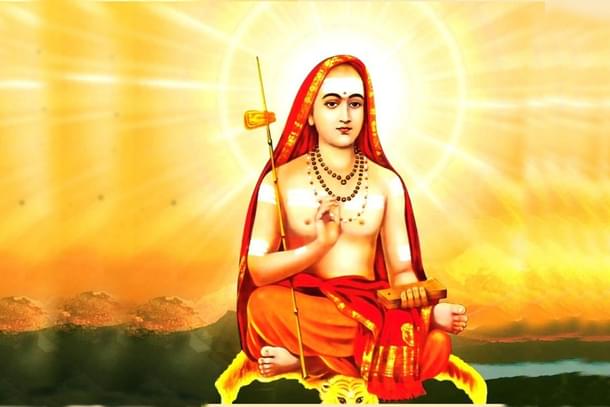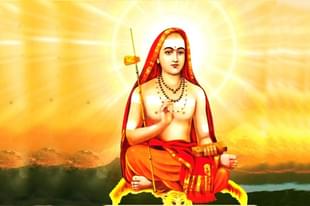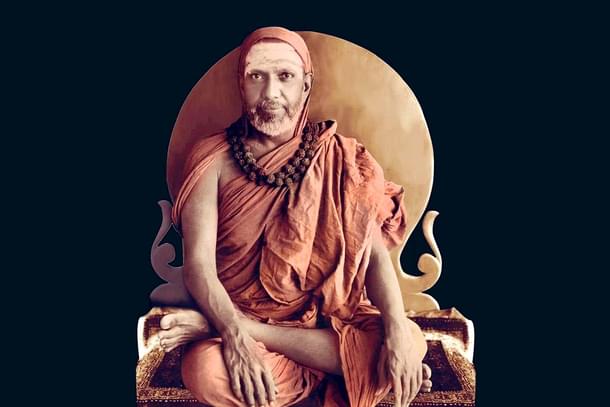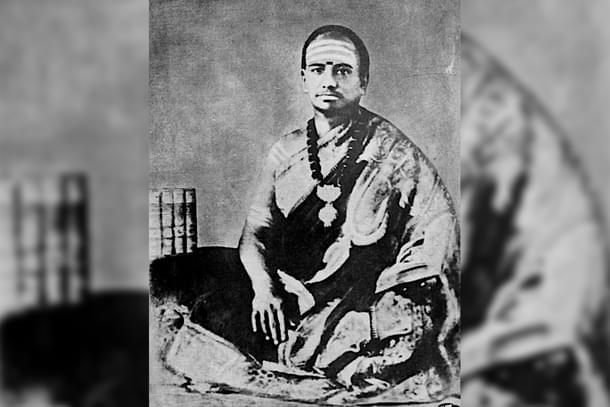Culture
[Long Read] Sri Shankara Granthavali – The Rebirth of Adi Shankara
Veejay Sai
May 17, 2021, 01:38 PM | Updated 01:38 PM IST
Save & read from anywhere!
Bookmark stories for easy access on any device or the Swarajya app.


The headline might sound like a misnomer, because someone of the stature of Shankara has no rebirth. However, he took multiple Avatars for our benefit and this is a story of some of those reincarnations.
Jagadguru Adi Shankara Bhagavadpadacharya doesn’t need any introduction. At a time when Sanatana Dharma was being threatened by all kinds of negative forces, he resurrected, rejuvenated and brought about a renaissance to the spiritual soul of India.
That Adi Shankara was born in Kalady was known to everyone. But where exactly was Kalady? This was re-discovered by the 33rd Jagadguru of Sringeri Sharada Peetham, Sri Sachidananda Shivabhinava Narasimha Bharathi Mahaswamiji (1858-1912).

He not only found out the exact place of birth but also consecrated a temple in the very spot. He was responsible for establishing the correct date of birth of Adi Shankara and the world continues to celebrate Shankara Jayanthi from then.
An Advaitin of the highest order, the Mahaswamiji was a prolific composer in Sanskrit. In addition to the Kalady temple, he also re-discovered the Adhishtanam of the great saint Sadasiva Brahmendra in Nerur. He was instrumental in getting the works of Jagadguru Adi Shankara Bhagavatpada for the first time in a series of books and gifting the world a precious spiritual legacy.
But that didn’t happen overnight. Nor was it easy. This is a story of how it came about, what were the incidents that lead to such a grand endeavour.
Unfortunately, our modern school education doesn’t teach us these kind of important incidents nor considers it history.
Inspite of all the regular onslaughts across the country, if Sanatana Dharma continued to survive upto this century in some or the other form, it is because of the unparalleled dedication, sacrifice and devotion of so many great Dharmik souls and institutions. The story of TKB is one important chapter in the modern revival of Sanatana Dharma.
TKB – A Crown Jewel Among Devotees
It is unbelievable how less information we have about the life of a person who lived less than a century ago. I had to scramble through all kinds of resources to put together this little about him.
Often, facts were wrong, dates were wrong, events and places didn’t come together in little stories. We are a country that takes documentation for granted. As a result, we end up with embarrassingly negligible accounts of lives of great people, who should ideally be celebrated for their phenomenal contributions.
TKB’s is one such story, scattered in a hundred fragmented memories. His life should be the subject for many a PhD thesis.
We have very scant information about TK Balasubrahmanyam’s early life.
“The latter half of the nineteenth century was a seed-time for Indian renaissance. Some of the greatest Indians of modern times were born then. Among them, Swami Vivekananda, Mahatma Gandhi and Sri Aurobindo. Tamil Nadu was particularly rich in this respect. Subramania Bharati readily comes to mind. To this race of barrier- breakers belonged Gurubhaktha Sikhamani T. K. Balasubrahmanyam Iyer of Srirangam. Born in 1874, Balasubramanyam hailed from a prosperous family of Thanjavur. He showed a remarkable aptitude for scholarship when still young. Mastering Tamil, Sanskrit and English speedily, he graduated from S.P.G. College, Tiruchi”, wrote the great Shrivaishnava scholar and translator Dr Prema Nandakumar of Srirangam, in an older essay on TKB.
The Vani Vilas Press was founded in 1904 by TK Balasubrahmanyam Iyer in Srirangam.
‘TKB’ as he came to be popular was a great devotee on a grand mission. He was interested in publishing all the great classics of Sanskrit literature.
Till then, most Sanskrit books were published by oriental series backed by royal patronage.
We had the Travancore Oriental Series, the Baroda series, books by Tukaram Jawaji and so forth.
According to Sri Gokulakrishna Iyer, an Ayurveda practitioner and a scholar residing in Srirangam, TKB had already published a large number of works. “For the first time the works of the great Avadhoota Sadasiva Brahmendra (18th century), the great Advaitin, philosopher and poet Srimad Appayya Diksita (1520 -1593) were published by TKB.
"In addition to that, scores of other works like Sanskrit commentaries on Sadhana Panchakam, Shastra Deepika of Parthasarathy Mishra, Nigrahashtakam, Sanskrit commentary on Desika’s ‘Yadavabhyudayam’, were published for the first time by TKB”, says Iyer.
“Hundreds of years ago when the great Appayya Diksita visited Srirangam, it is said that he was stopped from entering the temple by the Vaishnavas who misunderstood him to be a hater of Vishnu. Diksita is supposed to have sat outside near the Chandra Pushkarini, he meditated on the form of lord Ranganatha. The next morning when the priests opened the temple doors, they found the Murti looked like Shiva! They realized their mistake and sought pardon from Diksita. He composed a beautiful poem on lord Ranganatha. So in the same place, hundreds of years later, in the heart of South Chitra Veedhi, TKB published the works of Diksita for the first time! Don’t you think this is a divine design?”, asked Iyer, unable to stop his excitement.
Indeed, TKB was no ordinary man and his work with the Vani Vilas Press speaks volumes about the genius he was.
They say one meets their Guru by divine ordinance. So, TKB saw his destiny drawn towards the ancient temple of Jambukeshwarar and Devi Akhilandeshwari where the Sringeri Jagadguru was visiting.
From there, the Guru’s palanquin was heading towards Srirangam. TKB stood there with a tray full of offerings. Their eyes met and TKB’s destiny changed forever.
As TKB walked along, the Guru gently explained to him, in great detail, a verse from the Bhagawad Gita and the Shankara Bhashya for it.
This incident left an indelible impression on TKB’s mind. He decided to pursue his work with a new found passion.
In 1908, the Jagadguru was on another Yatra. TKB visited him to pay his obeisance. The Guru commanded him to publish the ‘Brahmasutra Vritti’ of Sadasiva Brahmendra.
Without wasting time TKB got on to the work and completed it and presented it to the Acharya on 20 January 1909.
It was a test of sorts and TKB had passed!
Then came the bigger one!
“It was at Papanasam in the Tinnevelly District that His Holiness first conceived the idea of a uniform and accurate edition of all the genuine works of the great world-teacher whose writings are the wonders of the world.
"This publication was considered by His Holiness to be a fitting supplement to the consecration of the temple of Sri Sankara at Kaladi. Accordingly His Holiness commanded me to print and publish a uniform and as far as possible an accurate edition of all the available works of this mighty intellect and make it a memorial of the consecration at Kaladi.
"In obedience to His esteemed commands and with the help of His divine blessings I commenced this publication in August 1909”, writes TKB, in the concluding note of how he went about this mammoth task.
The Guru also composed a prayer ‘Ratnagarbhaherambahstavah’ to Lord Ratnagarbah Ganapati of Sringeri, so this massive project would be successful.
The 33rd Jagadguru of Sringeri was a prolific composer, especially in Sanskrit.
We are currently reeling in the midst of a dreadful global pandemic. But a century ago, a similar pandemic had struck. The Jagadguru composed the famous ‘Durga Parameshwari Stotram’ to goddess Vana Durga, one of the guardian deities of Sringeri, and there was not a single fatality reported from there.
We have records in the State gazettes of how much destruction that pandemic caused all over the place. Thanks to the efforts of TKB, the Guru’s compositions were published in a handsome volume titled ‘Bhakthi Sudha Tarangini’ in 1913.
The consecration of the Kalady temple was held on 21 February 1910. TKB had less than six months to finish this task. If you know how modern day publishing industry works, despite all the great technological advancement, you will see TKB’s efforts were nothing short of super human.
He promptly began gathering data. From contacting the right kind of scholars to decoding palm leaf manuscripts that were lying around for centuries, unattended, the task TKB had agreed to was a nightmare for any publisher.
“The difficulties that beset me were innumerable and I had to overcome them one after another by sheer dogged pertinacity and by my firm faith in the righteousness of His commands.
"A sum of Rupees Forty thousand had to be invested before the work could be issued and though I unhesitatingly and ungrudgingly provided the funds, I had to meet quite unforeseen difficulties from unexpected quarters.
"The electric installation would fail me all on a sudden, the engine would refuse to move a bit, the machine would break and the necessary repairing facilities could not be had locally, types could not be secured immediately, papers had to be indented for from England where labour troubles would considerably impede their shipment, compositors would fall sick and absent themselves at all times, proof readers would run away, pundits who helped me would resent some imaginary affronts and keep away, near and dear relations would fall sick, and some would even die thus upsetting completely my mental equilibrium, these and others such as these, too numerous to detail, have tried their utmost to dissuade me from my set purpose.
"But on all these occasions invariably I had a cheering word or two from the lips of His Holiness and His beneficent smile would goad me on to my task with renewed vigour and fresh zeal”, writes TKB, narrating a glimpse of his woes.
Forty thousand rupees a century ago was big money by all standards. But TKB’s missionary zeal didn’t let him compromise on anything.
Though ten volumes of ‘Sri Shankara Granthavali’ were ready, only six were bound. If you see the binding of those books, even today, TKB’s love and devotion speaks through and through.
Each book is cloth-bound, embossed with pure gold inlay work, the best available paper was sourced from England, the art work inside on each page is exquisite and each page was finely crafted.

They are on par with any of the Oxford or Harvard classics published in that era. One wonders how he found the time for such incredible detailing in the short duration he had to fulfil his master’s command.
These six volumes were presented at the Kumbhabhishekam of the Kalady temple. The Guru in his Anugraha Bhashanam said something extraordinary.
I have consecrated the image (moorthi) of Adi Sankara in this place, Kaladi. But Balasubramaniam has consecrated Adi Sankara’s fame (keerthi) all over the world through the Sankara Granthavali.
What a rich compliment! What else would a shishya want from his guru other than such bountiful blessings.
TKB’s work didn’t end with that.
He returned to Srirangam and completed the remaining volumes and decided to present them too.
In the meantime, the Acharya entered Maha Samadhi, leaving a shattered TKB.
He mustered his strength and took the remaining volumes, packed in a beautiful rosewood box, custom-made for these books and presented them to Sri Chandrashekhara Bharathi Mahaswamiji (1892-1954), the 34th Jagadguru of Sringeri.
He was blessed by the Acharya and honoured with the title of ‘Guru Bhaktha Shikhamani’, ‘a crown jewel among devotees’.

TKB continued to strive for excellence with his Press, publishing priceless works of Dharmic literature.
In 1933, TKB established the ‘Sri Shankara Gurukulam’ in Srirangam.
By 1939, he had completed the main Sannidhi to Goddess Sharada Devi and founded the Sachidananda Bhandaram, a grand library of rare books and manuscripts, accessible for everyone.
“The concept of libraries meant for public use has been a revered tradition in India. Today, as it has become virtually impossible to have the luxury of personal libraries due to constraints of living space, public libraries ought to be maintained for the sake of the community.
"In this context it is good to know that the significant library of Sri Sankara Gurukulam at Srirangam is being renovated and refurbished. Having built the shrine for Adi Sankara at Srirangam and set up a school for teaching the Vedas and the Vani Vilas Press in the early decades of the twentieth century, Gurubhakta Sikhamani T.K.Balasubramania Iyer proceeded to create a library attached to the Gurukulam. The foundation for the Sri Sachidananda Bharati Bhandaram was laid in 1934, says the plaque in Tamil at the entrance to the large library hall. I spend hours here”, wrote Dr Prema Nandakumar, in an earlier piece on the place.
The major floods of Trichy in 1977 affected Srirangam too.
One of the places that was damaged was this priceless library. “Over two thousand books, rare manuscripts were damaged and had to be disposed. We lost almost all the information about TKB. Whatever we have is from a little Sanskrit poem written in his honour and published in a volume after his demise. That also we have it incomplete!”, recollected Gokulakrishna Iyer, with a heartbreak in his voice.
Iyer is passionate about keeping the legacy of TKB alive. In his lecture series, popular on YouTube, you can hear him referring to TKB time and again. As Iyer mentioned this, I kept wondering how much of our precious legacy we lost.
Age leaves none and TKB was no exception. By 1947, he was a frail old man, dealing with health problems that come with age. He had done his little service and knew his days were nearing. His deteriorating health kept everyone anxious. He thought of taking ‘Aapath Sanyasa’.
This was conveyed to the Jagadguru in Sringeri through his friend and colleague Krishnaswamy Iyer. His Holiness blessed him with a Srimukham and ordered one Shankarananda Saraswathi Swamigal from Krishnarajapuram in Karur district to do the needful.
The Swamigal travelled to Srirangam for this. On a pre-decided day and muhurtam, TKB received the sanyasa deeksha. His new name was Vignanananda Saraswati.
For those 48 hours, TKB who was almost bed-ridden till then, found unusual physical strength to perform all the prescribed rituals for sanyasis.
After all this was over, his health deteriorated further and the end came soon.
“It was Vaishakha Krishna Prathama on the traditional calendar. He raised both his hands and loudly exclaimed “Shivoham!” and collapsed”, recollected Gokulakrishna Iyer.
“It is amazing. Only a few years before that, he had published a book called ‘Jeevanmukti Kalyana Nataka’, an allegorical drama in Sanskrit. It was written by Nalla Dikshitar, a direct descendant of Neelakantah Diksita and one of the Gurus of Sadasiva Brahmandra. It seems he had a premonition of sorts about his end”, says Iyer.
He was given a samadhi, like sanyasis must be, on the banks of the Kaveri river and an Adhishtanam was built above that spot.
Before he passed away, TKB wrote off all his properties to the Sringeri Sharada Peetham. It was his final dakshina to his Gurus.
Towards the end of his note, TKB wrote, “In conclusion, I would deem myself amply rewarded if, by the publication of this edition, I have in any way helped towards the stemming of the tide of materialism that sweeps over our country just at present and towards infusing into the minds of the modern rationalists of India a respect and reverence towards the teachings of the friend, philosopher and guide of India, Sri Sankara Bhagavatpadacharya, the most rationalistic teacher the world has ever produced and the mightiest intellect of whom India is always justly proud.”
As India emerged into an independent nation, the great TKB left behind a large corpus of traditional and classical works as a cultural legacy to inherit, so future generations could benefit.
This twentyv-olume set of ‘Sri Shankara Granthavali’ should ideally be in the home of every devout Hindu, alongside the Ramayana, the Mahabharata, the Shrimad Bhagavatam and the Devi Bhagavatam.
The TKB chapter doesn’t end here. There is more.
Through various sources in Srirangam, we learn that the final resting place of TKB is a state of utter neglect. Several of his properties have been demolished and occupied illegally by local politicians and goons.
Dharmikas must come together to reclaim the legacy of TKB and what he stood for all his life.
The Rebirth of 'Sri Shankara Granthavali'
The sign of some of the greatest projects has been how they were done silently, driven by passion and dedication of a few individuals. If TKB was one such person, the other is Prof Yogananda of Mysore.
For a decade or more now, his organisation, Sriranga Digital, has been silently doing some phenomenal service for the cause of Dharma, without any support from anyone.
They are experts in archiving and digitising.
In addition to the complete archives of institutions like the Bharatiya Vidya Bhavan, the Ramakrishna Mission, Zoological Survey of India, Bombay Natural History Society, IIT, Madras, IISc, Bangalore, Gokhale Institute of Public Affairs, Raza Foundation, Botanical Survey of India, Tata Institute of Fundamental Research, Samskrita Bharati, the entire Rig Veda of the Jayachamaraja Granthamala, they have also digitised hundreds of precious works.
Sriranga Digital’s primary intention is to bring digital technologies in service of Indian languages and they have made a good name for themselves in this field. Though a young company, their work has been consistently impressive in this niche area.
Yogananda is a professor of mathematics. Inspired by the great mathematician Bhaskaracharya II of the 12th century, he had established ‘The Lilavati Trust’ long ago and published a number of works to create awareness for children about the beauty of mathematics. In his latest avatar as the proprietor of Sriranga Digital, his passion to digitise Indian works of literature has driven him far.
The ‘Sri Shankara Granthavali’ was yet another mammoth project. “It has six thousand five hundred pages in twenty volumes, out of which three hundred pages are just table of contents”, said Prof Yogananda who took a year of aggressive scouting, gathering and scanning all the volumes. I thought a whole ready-reckoner was possible from those three hundred pages.
The tricky part with old books is, you rarely find them in mint condition. Often if the book is good, you’ll find pages missing, or termite-eaten. To trace all the twenty volumes in best condition itself is a huge task.
Then comes the expertise in scanning and editing. “The difference between how we scan and what is available is very different. It is about the multiple points of access into a book. A normal book is 3-D and you can browse it as you want. But a scanned book is 2-D and if I ask you to find me a particular word or a paragraph, you will have to wade through all the pages to reach that part. We have made it easier in our search. You can search the works with words and reach there easily. This would greatly help research scholars, Pundits and academics alike”, added Yogananda.
Some of these volumes are available as badly scanned PDF copies on the internet archive, but nothing comes close to the quality of work done by Yogananda.
A superficial look at the volumes tell you, the first three are Brahmasutra Bhashyam, the next six are Upanishad Bhashyam covering Isha, Kena, Katha, Prashna, Mundaka, Mandukya, Ethareya, Taittriya, Chandogya and Brihadaranyakopanishads.
The tenth volume is the Lalita Trishati Bhashyam, the next two are Srimad Bhagawad Gita Bhashyam, the thirtheenth volume has Vishnu Sahasranama Bhashyam and Sanathsujathi Bhashyam.
The fourteenth volume has Vivekachoodamani and Upadesha Sahasri. The next two volumes titled ‘Prakarana Prabandhavali’ contain works like ‘Dashasloki’, ‘Sarvavedantasarasangraha’, ‘Manisha Panchakam’ and so forth.
The next two volumes are collection of the numerous stotras to various gods, and the final two volumes are the ‘Prapancha Saarah’.
Even with all the advanced technology around us, putting out such scholarly volumes sounds next to impossible in this day and age. Imagine what kind of passion drove TKB to accomplish this, over a century ago.
All these volumes come in a little handy portable microchip. Those of you interested to acquire a copy can email Yogananda at – sriranga.yoga@gmail.com.
This project has been blessed by the current Ubhaya Jagadgurus, Sri Bharathi Theertha Mahaswamiji and Sri Vidhu Shekhara Bharathi Mahaswamiiji of Sringeri and earned the praise of scores of spiritual leaders and saints alike.
As we celebrate another ‘Shankara Jayanthi’ across the world, it might be a good time to read, or re-read the message the great saint, philosopher and renaissance man of Sanatana Dharma left for us to follow.
Technology and the dedication of individuals like TKB and later Yogananda has helped these precious works reach us.
The ‘Sri Shankara Granthavali’ is a collectable for everyone interested in following the path of Sanatana Dharma
Veejay Sai is an award-winning writer, editor, columnist and culture critic. He has written and published extensively on Indian classical performing arts, cultural history and heritage, and Sanskrit. He is the author of 'Drama Queens: Women Who Created History On Stage' (Roli Books-2017) and ‘The Many Lives of Mangalampalli Balamuralikrishna' (Penguin Random House -2022). He lives in New Delhi.





